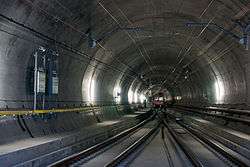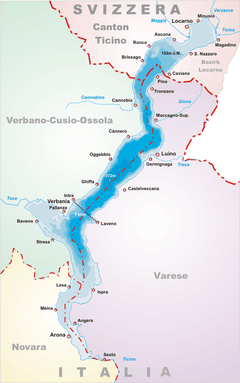Canton of Ticino
The canton of Ticino (/tɪˈtʃiːnoʊ/), formally the Republic and Canton of Ticino,[lower-alpha 1] is the southernmost canton of Switzerland. Ticino borders the canton of Uri to the north, the canton of Valais to the west (through the Novena Pass), the canton of Grisons to the northeast, and Italy's regions of Piedmont and Lombardy to the south, and it surrounds the small Italian enclave of Campione d'Italia.
Repubblica e Cantone Ticino | |
|---|---|
 Coat of arms | |
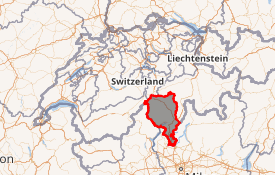
Location in Switzerland
Map of Ticino 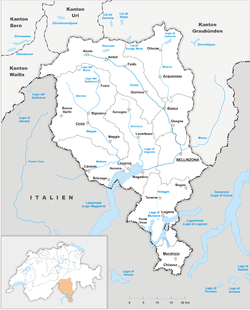 | |
| Coordinates: 46°19′N 8°49′E | |
| Country | Switzerland |
| Capital | Bellinzona |
| Largest City | Lugano |
| Subdivisions | 115 municipalities, 8 districts |
| Government | |
| • Executive | Council of State (5) |
| • Legislative | Grand Council (90) |
| Area | |
| • Total | 2,812.21 km2 (1,085.80 sq mi) |
| Population (December 2018)[2] | |
| • Total | 353,343 |
| • Density | 130/km2 (330/sq mi) |
| ISO 3166 code | CH-TI |
| Highest point | 3,402 m (11,161 ft): Adula (Rheinwaldhorn) |
| Lowest point | 195 m (640 ft): Lake Maggiore |
| Joined | 1803 |
| Languages | Italian |
| Website | www |
Named after the river Ticino, it is the only canton where Italian is the sole official language and represents the bulk of the Italian-speaking area of Switzerland along with the southern parts of Graubünden.
The land now occupied by the canton was annexed from Italian cities in the 15th century by various Swiss forces in the last transalpine campaigns of the Old Swiss Confederacy. In the Helvetic Republic, established 1798, it was divided between the two new cantons of Bellinzona and Lugano. The creation of the Swiss Confederation in 1803 saw these two cantons combine to form the modern canton of Ticino.
Etymology
The name Ticino was chosen for the newly established canton in 1803, after the river Ticino which flows through it from the Novena Pass to Lake Maggiore.[3]
Known as Ticinus in Roman times, the river appears on the Tabula Peutingeriana as Ticenum. Johann Kaspar Zeuss attributed Celtic origins to the name, tracing it to the Celtic tek, itself from an Indo-European root tak, meaning "melting, flowing".[4]
History
In ancient times, the area of what is today Ticino was settled by the Lepontii, a Celtic tribe. Later, probably around the rule of Augustus, it became part of the Roman Empire. After the fall of the Western Empire, it was ruled by the Ostrogoths, the Lombards and the Franks. Around 1100 it was the centre of struggle between the free communes of Milan and Como: in the 14th century it was acquired by the Visconti, Dukes of Milan. In the fifteenth century the Swiss Confederates conquered the valleys south of the Alps in three separate conquests.
Between 1403 and 1422 some of these lands were already annexed by forces from the canton of Uri, but subsequently lost. Uri conquered the Leventina Valley in 1440.[5] In a second conquest Uri, Schwyz and Nidwalden gained the town of Bellinzona and the Riviera in 1500.[5] Some of the land and Bellinzona itself were previously annexed by Uri in 1419 but lost again in 1422. The third conquest was fought by troops from the entire Confederation (at that time constituted by 12 cantons). In 1512 Locarno, the Maggia Valley, Lugano and Mendrisio were annexed. Subsequently, the upper valley of the river Ticino, from the St. Gotthard to the town of Biasca (Leventina Valley) was part of Uri. The remaining territory (Baliaggi Ultramontani, Ennetbergische Vogteien, the Bailiwicks Beyond the Mountains) was administered by the Twelve Cantons. These districts were governed by bailiffs holding office for two years and purchasing it from the members of the League.[5]

The lands of the canton of Ticino are the last lands to be conquered by the Swiss Confederation. The Confederation gave up any further conquests after their defeat at the battle of Marignano in 1515 by Francis I of France. The Val Leventina revolted unsuccessfully against Uri in 1755.[5] In February 1798 an attempt of annexation by the Cisalpine Republic was repelled by a volunteer militia in Lugano. Between 1798 and 1803, during the Helvetic Republic, two cantons were created (Bellinzona and Lugano) but in 1803 the two were unified to form the canton of Ticino that joined the Swiss Confederation as a full member in the same year under the Act of Mediation.[5] During the Napoleonic Wars, many Ticinesi (as was the case for other Swiss) served in Swiss military units allied with the French. The canton minted its own currency, the Ticinese franco, between 1813 and 1850, when it began use of the Swiss franc.
In the early 19th century, the contemporary Franco-Danish scholar Conrad Malte-Brun stated that: "The canton of Tesino [Ticino] is the poorest, and the people the most ignorant of any in Switzerland.[6] Until 1878 the three largest cities, Bellinzona, Lugano and Locarno, alternated as capital of the canton. In 1878, however, Bellinzona became the only and permanent capital. The 1870–1891 period saw a surge of political turbulence in Ticino, and the authorities needed the assistance of the federal government to restore order in several instances, in 1870, 1876, 1889 and 1890–1891.[7]
The current cantonal constitution dates from 1997. The previous constitution, heavily modified, was codified in 1830, nearly 20 years before the constitution of the Swiss Confederation.[8]
Geography
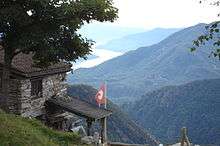
The canton of Ticino is in the south of Switzerland, almost entirely surrounded by Italy (to its west, south and much of its east). To the north are the cantons of Valais and Uri, to the northeast the canton of Graubünden.
Its area is 2,812 square kilometres (1,086 sq mi), of which about three-quarters are considered productive to trees or crops.[9] Forests cover about a third of the area, but also the lakes Maggiore (or Verbano) and Lugano (or Ceresio) make up a considerable minority.
Lying entirely in the south of the Alps, the canton can be split into two at the Monte Ceneri pass. The northern, highest part, the Sopraceneri, is formed by the two major Swiss valleys around Lake Maggiore: the valley of the Ticino, the Leventina Valley, and Maggia Valley. The southern part, the Sottoceneri, is the region around Lake Lugano.
The Ticino is the largest river in the canton. It drains most of the canton, flowing from the northwest through the Bedretto Valley and the Leventina Valley to enter Lake Maggiore near Locarno. Its main tributaries are the Brenno in the Blenio Valley and the Moesa in the Mesolcina Valley in Graubünden. The lands of most of the canton are shaped by the river, which in its mid portion forms a wide valley, commonly known as the Riviera.
The western lands of the canton, however, are drained by the Maggia. The Verzasca Valley is between the Leventina Valley and the Maggia Valley. There is also a smaller area that drains directly into the Lake Lugano. Most of the land is considered within the Alps (Lepontine Alps), but a small area is part of the plain of the Po which drains the north of Italy.
Climate
The climate of Ticino, while remaining alpine, is noticeably milder than the rest of Switzerland's, enjoying a higher number of sunshine hours and generally warmer temperatures.[10] In German-speaking Switzerland, Ticino is nicknamed Sonnenstube (sun porch), owing to the more than 2,300 sunshine hours the canton receives every year, compared to 1,700 for Zurich.[11]
Diocese
The Roman Catholic Diocese of Lugano is co-extensive to the canton.
Wine region
Ticino is one of the wine regions for Swiss wine. The defined region encompasses all of the canton plus the neighbouring Italian-speaking district of Moesa (Misox and Calanca valleys) in the canton of the Grisons.
Government
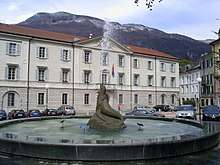
The current Constitution of the Republic and canton of Ticino, originating from a draft approved on 18 August 1801 during the Helvetic Republic,[12] was approved on 14 December 1997.[13] In its preamble, it states that it was created by the Ticinese people (popolo) "in order to guaranty peaceful life together with respect for the dignity of man, fundamental liberties and social justice (...) faithful to its historic task to interpret Italian culture within the Helvetic Confederation".[13]
The Grand Council (Gran Consiglio) is the legislative authority of the canton, exercising sovereignty over any matter not explicitly delegated by the constitution to another authority.[13] The Gran Consiglio has 90 members called deputati (deputies), elected in a single constituency using the proportional representation system.[13] Deputies serve four-year terms, and annually nominate a President and two Vice-Presidents. The Gran Consiglio meets in Bellinzona, the cantonal capital.[13]
The five-member Council of State (Italian: Consiglio di Stato), not to be confused with the federal Council of States, is the executive authority of the canton, and it directs cantonal affairs according to law and the constitution. It is elected in a single constituency using the proportional representation system. Currently, the five members of the Government are: Claudio Zali, Raffaele De Rosa, Manuele Bertoli, Norman Gobbi and Christian Vitta.
Each year, the Council of State nominates its president.[13] The current president of the Council of State is Norman Gobbi.[14]
The most recent elections were held in April 2015; the next elections will be on 7 April 2019.[15]
Politics
Federal election results
| Percentage of the total vote per party in the canton in the National Council Elections 1971–2015[16] | ||||||||||||||
|---|---|---|---|---|---|---|---|---|---|---|---|---|---|---|
| Party | Ideology | 1971 | 1975 | 1979 | 1983 | 1987 | 1991 | 1995 | 1999 | 2003 | 2007 | 2011 | 2015 | |
| FDP.The Liberalsa | Classical liberalism | 38.4 | 39.1 | 36.3 | 37.9 | 34.8 | 29.4 | 30.5 | 27.7 | 29.8 | 28.1 | 24.8 | 23.7 | |
| CVP/PDC/PPD/PCD | Christian democracy | 34.8 | 35.7 | 34.1 | 34.0 | 38.2 | 26.9 | 28.4 | 25.9 | 24.6 | 24.1 | 20.0 | 20.1 | |
| SP/PS | Social democracy | 13.1 | 13.9 | 15.2 | 13.8 | 9.3 | 6.7 | 17.1 | 18.8 | 25.8 | 18.1 | 16.6 | 15.9 | |
| SVP/UDC | Conservatism | 2.4 | * b | 2.3 | 2.1 | 1.3 | 1.0 | 1.5 | 5.3 | 7.6 | 8.7 | 9.7 | 11.3 | |
| EVP/PEV | Christian democracy | * | * | * | * | * | * | * | 0.2 | * | * | * | * | |
| GLP/PVL | Green liberalism | * | * | * | * | * | * | * | * | * | * | * | 0.8 | |
| PdA/PST-POP/PC/PSL | Socialism | 2.8 | 3.6 | 2.7 | * | 1.2 | 0.7 | 1.3 | 1.3 | * | 1.3 | 1.2 | 0.5 | |
| PSA | Socialism | 6.7 | 7.6 | 9.4 | 10.6 | 11.0 | 10.0 | c | * | * | * | * | * | |
| GPS/PES | Green politics | * | * | * | * | 1.9 | 1.0 | 1.7 | 1.4 | 3.0 | 4.8 | 6.7 | 3.5 | |
| FGA | Feminist | * | * | * | * | 0.9 | * | * | * | * | * | * | * | |
| SD/DS | National conservatism | 1.8 | * | * | * | * | * | * | * | * | * | * | * | |
| Ticino League | Right-wing populism | * | * | * | * | * | 23.5 | 18.6 | 18.5 | 8.0 | 14.0 | 17.5 | 21.7 | |
| Other | * | 0.2 | * | 1.8 | 1.4 | 0.8 | 1.0 | 0.9 | 1.3 | 0.8 | 3.4 | 2.4 | ||
| Voter participation % | 60.6 | 64.7 | 59.6 | 61.6 | 60.2 | 67.5 | 52.8 | 49.7 | 48.6 | 47.4 | 54.3 | 54.4 | ||
Referendum decisions
Since a referendum in September 2013, Ticino is the only Swiss canton where wearing full-face veils is illegal.[17] Supporters of the ban cited the case of a 20-year-old Pakistani woman from Bellinzona, who was killed by her husband for refusing to wear a headscarf.[18][19] The Burqa ban was later approved by the Grand Council in November 2015.[20]
In September 2016, Ticino voters approved a Swiss People's Party-sponsored referendum that gives precedence to Swiss workers, as opposed to foreign workers, defying freedom of movement agreements between Switzerland and the EU.[21][22]
Political subdivisions
Districts
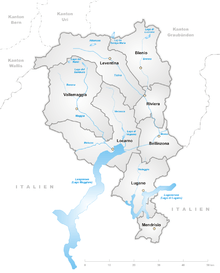
The canton is divided into eight districts:[23]
- Bellinzona with capital Bellinzona
- Blenio with capital Acquarossa
- Leventina with capital Faido
- Locarno with capital Locarno
- Lugano with capital Lugano
- Mendrisio with capital Mendrisio
- Riviera with capital Osogna
- Vallemaggia with capital Cevio
History of the districts
Leventina was a subject of the canton of Uri until 1798, the year the Helvetic Republic was founded, when it became part of the new canton of Bellinzona along with the Swiss condominiums of Bellinzona, Riviera and Blenio. The condominiums of Locarno, Lugano, Mendrisio and Vallemaggia became part of the new canton of Lugano in 1798. These two cantons formed into one canton – Ticino – in 1803 when it joined the (restored) Swiss Confederation as a member canton. The former condominiums and Leventina became the eight districts of the canton of Ticino, which exist to the present day and are provided for by the cantonal constitution.
Municipalities and circles
There are 115 municipalities in the canton (as of April 2017). These municipalities (comuni) are grouped in 38 circoli (circles or sub-districts) which are in turn grouped into the eight districts (distretti).[24]
The mayor (sindaco) is the president of the municipal government (municipio) which comprises at least three members; a council also exists. The members of the council and the municipio are elected every four years by the citizens resident in the comune – the next elections are scheduled for April 2020.[15]
Since the late 1990s there is an ongoing project to aggregate some municipalities, with the constitution of the canton allowing for the Grand Council of Ticino to promote and lead in deciding on mergers.[23] This has resulted in changes to some of the circles, with many circles now consisting of just one or two municipalities. The most populous municipality – Lugano (having merged with numerous other municipalities) – is subdivided into quartieri (quarters) which are grouped into three (cantonal) circles. In the modern day, the circle serves only as a territorial unit with limited public functions, most notably the local judiciary.
Demographics
Religion in canton of Ticino (age 15+, 2012)[25]
_View_on_Lake_Lugano_and_Monte_San_Salvatore.jpg)
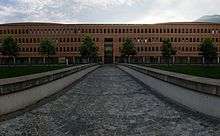
Ticino has a population (as of 31 December 2018) of 353,343.[2] As of 2013, the population included 94,366 foreigners, or about 27.2% of the total population. The largest groups of foreign population were Italians (46.2%), followed by Croats (6.5%) and the Portuguese (5.9%).[25] The population density (in 2005) is 114.6 persons per km2.[9] As of 2000, 83.1% of the population spoke Italian, 8.3% spoke German and 1.7% spoke Serbo-Croatian.[9]
As of 2016, 70.1% of total population is Roman Catholic.[26] According to a 2012 survey, the population aged 15 years and older is mostly Roman Catholic (70%), further Christian denominations account for 10% of the population (including Swiss Reformed 4%), 2% are Muslims and 1% of the population has another religion (including Jews 0.1%).[25]
The official language, and the one used for most written communication, is Swiss Italian. Despite being very similar to standard Italian, Swiss Italian presents some differences to the Italian spoken in Italy due to the influence of French and German from which it assimilates words. Dialects of the Lombard language such as Ticinese are still spoken, especially in the valleys, but they are not used for official purposes.
Despite the dominance of Italian-speakers, fluency in Standard German and Alemannic German is taken to be an important prerequisite for employment, regardless of sector or sphere of work.[27]
In 2016, Ticino was the European region with the second highest life expectancy at 85.0 years, and highest male life expectancy at 82.7 years.[28]
Economy
Tertiary sector workers make up 76.5% of the Ticinese workforce, compared to the Swiss average of 67.1%. Commerce (23.1%), tourism (10.1%) and financial activities (3.9%) are all important for the local economy, while the contribution from agriculture and fishing is marginal, employing 6.5% of the workforce on a Swiss average of 15.4%.[29] The median gross private sector monthly salary in 2012 was 5,091 francs (US$5,580), below the national average of 6,118 francs (US$6,703). [30] However, due to lesser cost of living and lower taxation compared to most other cantons, the overall disposable mean income is high.[31] The GDP per capita at 82,438 francs in 2014, was seventh highest in Switzerland.[32] Ticino is counted among the most prosperous regions of Switzerland and of Europe.[33]
Lugano is Switzerland's third largest financial center after Zurich and Geneva.[34] The banking industry alone has 8,400 employees and generates 17% of the gross cantonal product.[35] Because of Ticino's shared language and culture, its financial industry has very close ties to Italy.[35] In 2017, Ticino had an unemployment rate of 4%, higher than the Switzerland average where it was estimated at 3.7%.[36]
Frontalieri, commuter workers living in Italy (mostly in the provinces of Varese and Como) but working regularly in Ticino, form a large part (over 20%) of the workforce, far larger than in the rest of Switzerland, where the rate is below 5%. Foreigners in general hold 44.3% of all the jobs, again a much higher rate than elsewhere in the Confederation (27%).[37] Frontalieri are usually paid less than Swiss workers for their jobs, and tend to serve as low-cost labour.[38]
Italy is by far Ticino's most important foreign trading partner, but there's a huge trade deficit between imports (5 billion CHF) and exports (1.9 billion).[39] By 2013, Germany had become the canton's main export market, receiving 23.1% of the total, compared to 15.8% for Italy and 9.9% for the United States.[40] Many Italian companies relocate to Ticino, either temporarily or permanently, seeking lower taxes and an efficient bureaucracy:[41] just as many Ticinese entrepreneurs doing business in Italy complain of red tape and widespread protectionism.[42] The region has been attracting multinational companies particularly from the fashion industry due to its closeness to Milano. Hugo Boss, Gucci, VF Corporation and other popular brands are located there. Because the international fashion business has become a significant employer for Swiss and Italians alike, the region has also been termed the "Fashion Valley".[43]
Three of the world's largest gold refineries are based in Ticino,[44] including the Pamp refinery in Castel San Pietro, the leading manufacturer of minted gold bars.[45]
The opening of the Gotthard Railway in 1882 led to the establishment of a sizeable tourist industry mostly catering to German-speakers,[46] although since the early 2000s the industry has suffered from the competition of more distant destinations. In 2011, 1,728,888 overnight stays were recorded.[47] The mild climate throughout the year makes the canton a popular destination for hikers.[48] The Verzasca Dam, known for the opening scene of the 1995 film GoldenEye, is popular with bungee jumpers.[48] Swissminiatur in Melide is a miniature park featuring scale models of over 120 Swiss attractions.[49] The Brissago Islands on Lake Maggiore are the only Swiss islands south of the Alps, and house botanical gardens with 1,600 different plant species from five continents.[50]
Transport
Several tunnels underneath the Gotthard Pass connect the canton to northern Switzerland: the first to open was the 15 kilometres (9.3 mi) long Gotthard Rail Tunnel in 1882, replacing the pass road, connecting Airolo with Göschenen in the canton of Uri.[52] A 17 km (11 mi) motorway tunnel, the Gotthard Road Tunnel, opened in 1980.[53] A second rail tunnel through the pass, the Gotthard Base Tunnel, was opened on 1 June 2016. The new tunnel is the longest tunnel in the world,[51] reducing travel time between Zürich and Lugano to 1 hour 40 minutes.[51]
Treni Regionali Ticino Lombardia (TiLo), a joint venture between the Italian Ferrovie dello Stato and the Swiss Federal Railways launched in 2004, manages the traffic between the regional railways of Lombardy and the Ticino railway network via a S-Bahn system.[54]
The Regional Bus and Rail Company of Ticino provides the urban and suburban bus network of Locarno, operates the cable cars between Verdasio and Rasa, and between Intragna – Pila – Costa on behalf of the owning companies, and, together with an Italian company, the Centovalli and Vigezzina Railway which connects the Gotthard trans-Alpine rail route at Locarno with the Simplon trans-Alpine route.
The canton has a higher than average incidence of traffic accidents, recording 16 deaths or serious injuries per 100 million km in the 2004–2006 period, compared to a Swiss average of 6.[55]
Lugano Airport is the busiest airport in south east Switzerland, serving some 200,000 passengers a year.[56]
Education
There are two major centres of education and research located in the canton of Ticino. University of Italian Switzerland (USI, Università della Svizzera Italiana) in Lugano is the only Swiss university teaching primarily in Italian. The University of Applied Sciences and Arts of Southern Switzerland (SUPSI, Scuola Universitaria Professionale della Svizzera Italiana), in Manno, is a professional training college focused on a practical method of teaching in the areas of applied art, economy, social work, technology and production science.[35]
There is also a small American and Swiss accredited private college, Franklin University Switzerland, located above Lugano,[57] as well as The American School in Switzerland in Collina d'Oro, a K-13 international school accepting day and boarding students.
Culture

Ticino hosts two World Heritage sites: the Three Castles of Bellinzona and Monte San Giorgio.[58] The city of Locarno is host to the Locarno International Film Festival, Switzerland's most prestigious film festival, held during the second week of August.[59] Estival Jazz, a free open-air jazz festival, is held in Lugano and Mendrisio in late June and July.[60] Past lineups have included Buddy Guy, Van Morrison, Yes, Jethro Tull, Yellowjackets, Al Jarreau, Randy Brecker.[61]
Ticino has a rich architectural heritage, ranging from the anonymous rock architecture of grottos and splüi, over Romanesque and baroque to contemporary styles. Grottos were ubiquitous cellars in Ticino, and symbolize rustic, family-run restaurants in the latter part of the 20th century. They serve local wine (usually Merlot or similar) in a little ceramic jug known as boccalino, which is also a popular souvenir for tourists.[62]
The canton is home to internationally recognized architects, such as Mario Botta, Aurelio Galfetti, Luigi Snozzi, Livio Vacchini.[58] As early as the 18th century, aristocrats from Russia and Italy employed numerous architects from Ticino.[63] More recently, the region became a centre of the Neo-Rationalist Tendenza movement.[64]
Polenta, along with chestnuts and potatoes, was for centuries one of the staple foods in Ticino, and it remains a mainstay of local cuisine.[65]
Gazzosa ticinese, a soft drink available in lemon and a number of other flavours, is one of the most popular beverages from Ticino, and is also common in other regions of Switzerland. It usually comes in flip-top bottles.[66] The estimate for the production of gazzosa in Ticino is 7–8 million bottles a year.[67]
Newspapers and magazines published in Ticino include Corriere del Ticino, LaRegione Ticino, Giornale del Popolo, Il Mattino della Domenica, Il Caffè, L'Informatore, and the German-language Tessiner Zeitung.[68][69]
Bocce is a folk game that was once a popular pastime locally, but by the early 21st century it was seldom played by younger people.[70] Notable sports teams include HC Lugano, HC Ambrì-Piotta (ice hockey), FC Lugano (association football) and Lugano Tigers (basketball). Lugano has hosted the Italy-Belgium match at the 1954 FIFA World Cup, the 1953 and 1996 UCI Road World Championships, the 18th Chess Olympiad, and the annual BSI Challenger Lugano tennis tournament and Gran Premio Città di Lugano Memorial Albisetti 20 km racewalk.
Notable people
- Carla Del Ponte, international jurist
- Flora Ruchat-Roncati, architect
- Lara Gut-Behrami, ski racer
- Mario Botta, architect
- Aurelio Galfetti, architect
- Luigi Snozzi, architect
- Livio Vacchini, architect
- The Bernasconi family of stuccoists, architects and sculptors
- Giovanni Pietro Magni, stuccoist[71]
Notes
References
- Arealstatistik Land Cover - Kantone und Grossregionen nach 6 Hauptbereichen accessed 27 October 2017
- Swiss Federal Statistical Office - STAT-TAB, online database – Ständige und nichtständige Wohnbevölkerung nach institutionellen Gliederungen, Geburtsort und Staatsangehörigkeit (in German) accessed 23 September 2019
- "Lo scorrere del fiume, l'opera dell'uomo". Azienda elettrica ticinese. Archived from the original on 28 October 2014. Retrieved 28 October 2014.
- Roberto Rampoldi (1901). "Intorno all'origine e al significato del nome Ticino". Internet Archive. Retrieved 28 October 2014.
- "Switzerland". Encyclopædia Britannica. 26. 1911. pp. 933–4. Retrieved 23 October 2008.
- Malte-Brun, Conrad 2015[1824] Universal Geography: or A Description of All Parts of the World, on a New Plan, According to the Great Natural Divisions of the globe; Accompanied with Analytical, Synoptical, and Elementary Tables. Web page. Electronic document, https://archive.org/details/universalgeograp07malt
- Goldstein, Leslie Friedman (21 August 2001). Constituting Federal Sovereignty: The European Union in Comparative Context. JHU Press. p. 132 – via Internet Archive.
- "The Constitution of Ticino". Ti.ch. Archived from the original on 19 May 2006. Retrieved 28 January 2012.
- Federal Department of Statistics (2008). "Regional Statistics for Ticino". Archived from the original on 25 June 2008. Retrieved 23 November 2008.
- "Walkingworld – original article". Walkingworld.com. Retrieved 4 September 2019.
- Jürg Steiner; Manuschak Karnusian; Omar Gisler (28 March 2014). MARCO POLO Reiseführer Tessin. Mair Dumont Marco Polo. p. 23. ISBN 978-3-8297-7172-6.
- "Il Canton Ticino si appresta a festeggiare i suoi 200 anni" (in Italian). swissinfo. 20 August 2001. Retrieved 9 July 2009.
- "Constitution of the Republic and Canton of Ticino" (in Italian). Federal Authorities of the Swiss Confederation. 14 December 1997. Retrieved 9 July 2009.
- "Archived copy". Archived from the original on 29 August 2014. Retrieved 8 July 2014.CS1 maint: archived copy as title (link)
- "Comunicato stampa" (PDF). www3.ti.ch. 2017. Retrieved 4 September 2019.
- Nationalratswahlen: Stärke der Parteien nach Kantonen (Schweiz = 100%) (Report). Swiss Federal Statistical Office. 2015. Archived from the original on 2 August 2016. Retrieved 8 August 2016.
- Squires, Nick. "Burkas and niqabs banned from Swiss canton". Telegraph. Retrieved 29 October 2013.
- "Swiss charge Pakistani over 'honour killing' of wife". Daily Times. Archived from the original on 6 November 2014. Retrieved 6 November 2014.
- Giorgio Ghiringhelli. "Divieto di indossare negli spazi pubblici e nei luoghi privati aperti al pubblico indumenti che nascondano totalmente o parzialmente il volto (ad esempio il burqa e il niqab)" (PDF). Corriere del Ticino. Retrieved 6 November 2014.
- "MPs in Swiss canton of Ticino Back Burqa Ban". The Local. 24 November 2015. Retrieved 12 December 2016.
- "Ticino Votes to Favour Local Workers Over Foreigners". The Local. 26 September 2016. Retrieved 12 December 2016.
- Atkins, Ralph (25 September 2016). "Swiss Canton Votes for Tougher Controls on Foreign Workers". Financial Times. Retrieved 12 December 2016.
- "RS 131.229 Costituzione della Repubblica e Cantone Ticino, del 14 dicembre 1997". Admin.ch. Retrieved 4 September 2019.
- "CAN – Raccolta delle leggi del Cantone Ticino". www3.ti.ch.
- "Annuario Statistico Ticinese 2015" (in Italian). Ufficio di Statistica del Cantone Ticino. Retrieved 4 April 2019.
- "Diocese of Lugano – Statistics". Retrieved 4 April 2019.
- Mackey, William; Ornstein, Jacob (22 July 2011). "Sociolinguistic Studies in Language Contact: Methods and Cases". Walter de Gruyter – via Google Books.
- "Eurostat-Life expectancy at birth by sex and NUTS 2 region". Ec.europa.eu. Retrieved 18 December 2018.
- "Aziende per settore e sezione di attività economica" (PDF) (in Italian). Ufficio di statistica. 15 January 2008. Archived from the original (PDF) on 7 June 2011. Retrieved 8 July 2009.
- "Monatlicher Bruttolohn nach Grossregionen – Privater Sektor – Schweiz". Bundesamt für Statistik. Retrieved 14 November 2014. (exchange rate of 0.9126 on 31 December 2012)
- "Survey pinpoints least expensive places to live". Swissinfo.ch. Retrieved 4 September 2019.
- "Cantonal gross domestic product (GDP) per capita – 2008–2014 | Table". Federal Statistical Office. 28 October 2016. Retrieved 4 September 2019.
- "6 Swiss regions in Europe's 10 most prosperous". Lenews.ch. 12 May 2017. Retrieved 4 September 2019.
- "Far Right Party's Ad Campaign Draws Criticism in Switzerland". NYTimes.com. Retrieved 13 November 2014.
- "Ticino". United States Commercial Service. 14 March 2007. Archived from the original on 12 October 2008. Retrieved 6 November 2008.
- "Swiss unemployment rises. French-speaking cantons worst affected". Lenews.ch. 15 February 2017. Retrieved 4 September 2019.
- "Occupati stranieri e frontalieri" (PDF) (in Italian). Ufficio di statistica. 1 July 2009. Archived from the original (PDF) on 7 June 2011. Retrieved 8 July 2009.
- Frontalieri in German, French and Italian in the online Historical Dictionary of Switzerland.
- "Commercio estero" (PDF). Ufficio di statistica. 1 July 2009. Archived from the original (PDF) on 7 June 2011. Retrieved 8 July 2009.
- "Esportazioni secondo il paese di destinazione, dal Ticino, dal 2006". USTAT. Retrieved 6 December 2014.
- "Seicento ditte italiane in fuga verso il Ticino" (in Italian). Il caffè. 5 July 2009. Archived from the original on 12 February 2010. Retrieved 8 July 2009.
- "In Italia c'è ancora troppa burocrazia" (in Italian). Il Caffè. 5 July 2009. Archived from the original on 12 February 2010. Retrieved 8 July 2009.
- N. Rütti & A. Ramp (May 2017). "Zwischen dem Tessin und Italien – Nirgendwo in Mitteleuropa zeigt sich deutlicher, was der Wegfall von Grenzen bedeutet" (in German). Neue Zürcher Zeitung (Wirtschaft). Retrieved 30 May 2017.
- "Gold refineries – another Swiss money-spinner". BBC News. Retrieved 13 November 2014.
- "La Pamp SA si espande in India". CdT.ch. Retrieved 13 November 2014.
- "Die Sonnenstube der Schweiz: "Das Paradies ist hier!"". NZZ.ch. Retrieved 27 November 2014.
- "Tessiner Tourismuszahlen: Im Allzeittief". NZZ.ch. Retrieved 27 November 2014.
- "Ticino's warmer climate attracts hikers year-round". The Guardian. Retrieved 5 December 2014.
- Nicola Williams; Damien Simonis; Kerry Walker (2009). Switzerland. Lonely Planet. p. 334. ISBN 978-1-74220-381-2.
- "Floral paradise blossoms on Brissago islands". swissinfo.ch. Retrieved 5 December 2014.
- "Alp Transit 2016: verso nuovi equilibri territoriali" (PDF) (in Italian). Portal of canton of Ticino. 20 October 2006. Archived from the original (PDF) on 7 June 2011. Retrieved 8 July 2009.
- Hans-Peter Bärtschi: Gotthardbahn in German, French and Italian in the online Historical Dictionary of Switzerland, 29 July 2004.
- Gotthard Pass – The traffics from the late 19th century to the present in German, French and Italian in the online Historical Dictionary of Switzerland.
- "Tilo: un primo bilancio positivo" (PDF). Portal of canton of Ticino. Archived from the original (PDF) on 10 October 2007. Retrieved 8 July 2009.
- "Regional differences in traffic accidents – bfu-report no. 62 – bfu_2.041.08_bfu-report no. 62 – Regional differences in traffic accidents" (PDF). Bureau de prévention des accidents. p. 71. Archived from the original (PDF) on 4 March 2016. Retrieved 3 December 2014.
- "Airport traffic statistics" (PDF). Airports Council International. 6 December 2005. Archived from the original (PDF) on 20 November 2008. Retrieved 8 July 2009.
- "Archived copy". Archived from the original on 20 April 2012. Retrieved 15 April 2012.CS1 maint: archived copy as title (link)
- "Canton Ticino: a taste" (PDF). Swissnews.ch. Retrieved 5 December 2014.
- Max Oettli (2011). CultureShock! Switzerland. Marshall Cavendish. p. 189. ISBN 978-981-4435-93-2.
- Nicola Williams; Damien Simonis; Kerry Walker (2009). Switzerland. Lonely Planet. p. 330. ISBN 978-1-74220-381-2.
- Joanne Lane (1 July 2007). Adventure Guide to Sicily. Hunter Publishing, Inc. p. 165. ISBN 978-1-58843-627-6.
- "What is a Boccalino?". Boccalino Grotto. Archived from the original on 5 December 2014. Retrieved 27 November 2014.
- "The Architecture of Ticino "Tendenza" – a case of the past?" (PDF). BTU Cottbus. Retrieved 5 December 2014.
- K. Michael Hays (2000). Architecture Theory Since 1968. MIT Press. p. 246. ISBN 978-0-262-58188-2.
- "Tessiner Polenta". TicinoTopTen. Retrieved 27 November 2014.
- "Gazosa – die Kultlimonade aus dem Tessin". Schweizer Radio und Fernsehen. Retrieved 26 November 2014.
- "La gazzosa ticinese sfonda il Gottardo" (PDF). Il Caffè. Retrieved 26 November 2014.
- "Presse: les titres participants" (PDF). REMP. Retrieved 3 December 2014.
- "REMP bulletin des tirages 2014" (PDF). REMP. Retrieved 3 December 2014.
- "Boccia – vom Zeitvertreib zum Leistungssport: Kommen die Kugelschieber zu olympischen Ehren?". NZZ.ch. Retrieved 27 November 2014.
- Nicht, Christoph. "Pietro Magno und die italienischen Stukkateurtrupps" (PDF). Frankenland.franconica.uni-wuerzburg.de. Retrieved 4 September 2019.
Bibliography
- Marcello Sorce Keller,"Canton Ticino: una identità musicale?”, Cenobio, LII(2003), April–June, pp. 171–184; also later published in Bulletin – Schweizerische Gesellschaft für Musikethnologie und Gesellschaft für die Volksmusik in der Schweiz, October 2005, pp. 30–37.
External links
| Wikimedia Commons has media related to Canton of Ticino. |
- Cantone Ticino (in Italian) official site
- Ticino Tourism, official website of tourism office
- Official statistics
- "Ticino in a nutshell" (PDF). Repubblica e Cantone Ticino, Dipartimento delle istituzioni Residenza governativa. 2012. Retrieved 9 December 2019.
